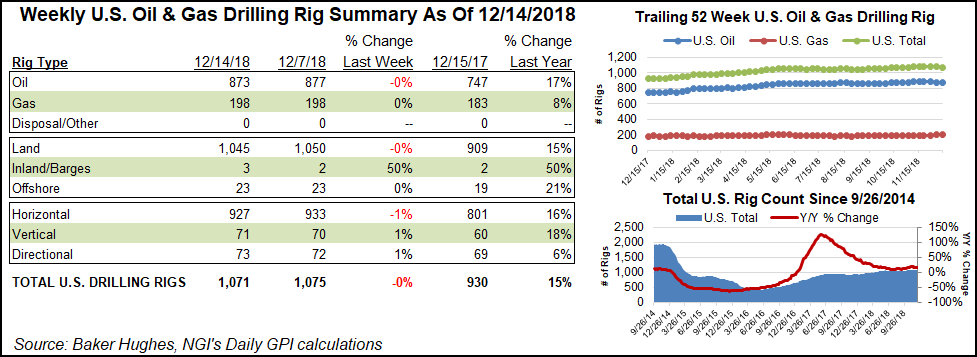NGI All News Access | E&P | Infrastructure
U.S. Natural Gas Drilling Steady as BHGE’s Oil Count Falls
The U.S. natural rig count finished even at 198 for the week ended Friday (Dec. 14) as a decline in oil activity sent the overall domestic tally lower, according to data from Baker Hughes, a GE Company (BHGE).

The United States dropped four rigs — all of them oil-directed — to finish at 1,071 for the week, with the total number of active oil rigs falling to 873. Six horizontal units packed up for the week, offsetting the addition of one directional rig and one vertical rig.
The week’s losses included five rigs on land, while one rig returned to work in inland waters. Gulf of Mexico activity held steady at 23 rigs, up from 19 a year ago.
Canada saw 12 rigs exit the patch for the week, including seven oil units and five gas units. Canada’s count finished at 174, lagging well behind its year-ago total of 238. The combined North American rig count finished the week at 1,245, up from 1,168 in the year-ago period.

Among plays, the oil-focused Permian and Williston basins each saw three rigs depart during the week. The Permian finished with 486 rigs as of Friday (397 a year ago), while the Williston fell to 53 units (48 a year ago), according to BHGE.
Also among plays, the Utica Shale added a rig for the week, as did the Eagle Ford Shale. The Arkoma Woodford, Granite Wash, Haynesville Shale, Marcellus Shale and Mississippian Lime each dropped a rig from their respective totals.
Among states, Wyoming saw a sharp uptick in activity, adding five rigs to finish at 35 (26 a year ago). New Mexico, on the other hand, shed five rigs for the week to fall to 105 (71 a year ago).
Also among states, Texas added three rigs, while Kansas and Ohio each picked up one. North Dakota and Oklahoma each lost two rigs on net, while Alaska and Pennsylvania each lost one, according to BHGE.
U.S. oil and natural gas permitting during November increased 60% from a year ago and was up by almost one-third month/month (m/m), aided by strong gains in Colorado, New Mexico and Wyoming, according to a recent analysis from Evercore ISI.
Each month the firm compiles permit data for U.S. land and offshore drilling activity using state and federal reports. Onshore permits usually are issued several months before drilling begins, while offshore permits often are secured even further in advance.
“A total of 6,360 permits were issued in the U.S. last month, which is the highest peak year-to-date, up 32% m/m and 60% year/year,” Evercore’s James West and his team said. “The data compares to the permit count high of 7,746 in August 2014 and the monthly onshore permit count peak of 8,441 in June 2008.”
Meanwhile, oil and natural gas companies added 2,400 upstream jobs to their Texas payrolls in October, marking the 23rd consecutive month of job growth, according to data from the Texas Workforce Commission.
© 2024 Natural Gas Intelligence. All rights reserved.
ISSN © 1532-1231 | ISSN © 2577-9877 |
